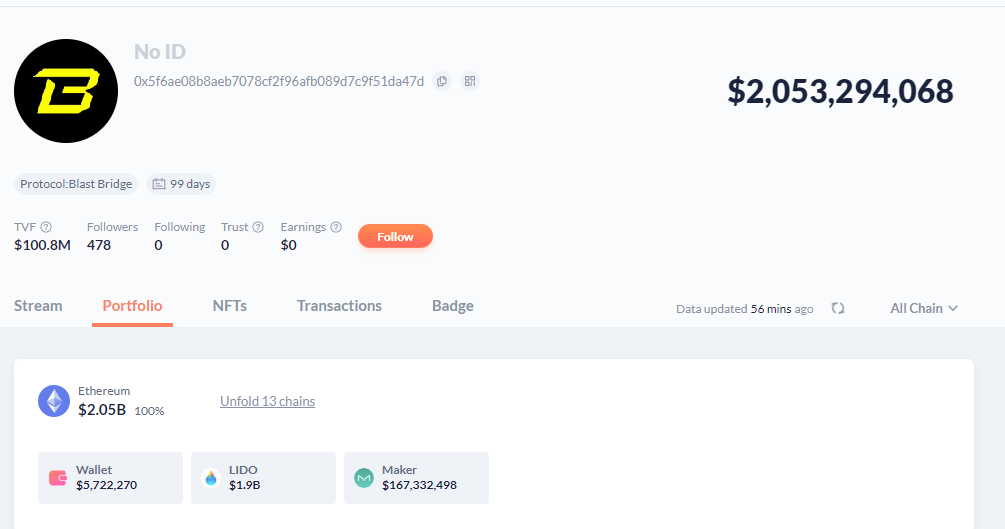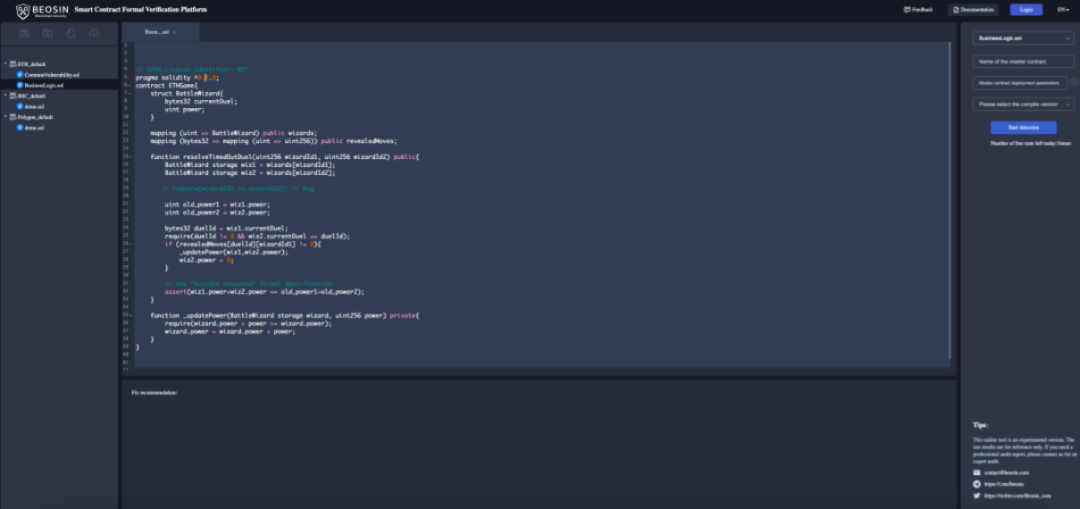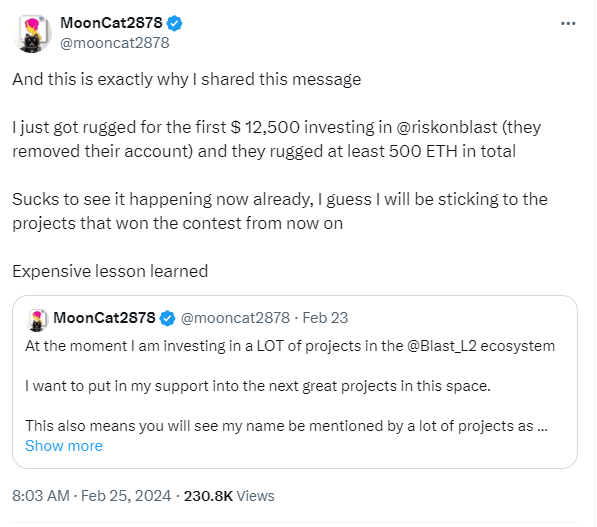 web3.0
web3.0
 The Blast mainnet is about to be launched, and its security risks and potential opportunities are analyzed from a technical perspective
The Blast mainnet is about to be launched, and its security risks and potential opportunities are analyzed from a technical perspective
The Blast mainnet is about to be launched, and its security risks and potential opportunities are analyzed from a technical perspective
php editor Xinyi recently discovered that the Blast mainnet is about to be launched, which has attracted widespread attention. However, the security risks that come with it have also attracted much attention, and it is necessary for us to conduct an in-depth analysis of its technical aspects. At the same time, potential opportunities cannot be ignored. Let us explore the challenges and opportunities in this emerging field.
Recently, Blast has once again become a hot topic in the market. With the end of its "Big Bang" developer competition, its TVL has continued to soar, exceeding 2 billion US dollars in one fell swoop, occupying the top spot on the Layer 2 track. Have a place.
At the same time, Blast also announced that it will launch its mainnet on February 29, causing the public to continue to pay attention to it. After all, the "anticipation of airdrop" has successfully attracted most participants to watch. However, with the development of its ecology, various projects emerge one after another, which also leads to the frequent occurrence of various security risks. Today Beosin will explain to you the security risks and potential opportunities behind Blast’s strong start and the surge in TVL.

Blast development history
Blast is a new project launched by Blur founder Pacman on November 21, 2023, which quickly attracted attention in the encryption community. extensive attention. In just 48 hours of launch, the network has reached a total value locked (TVL) of $570 million and attracted over 50,000 users.
Blast received US$20 million in financing from major backers such as Paradigm and Standard Crypto last year, followed by another US$5 million investment from Japanese cryptocurrency investment company CGV in November last year.
According to DeBank data, as of February 25, the total value of assets in the Blast contract address has exceeded US$2 billion, of which approximately US$1.8 billion of ETH is deposited in the Lido protocol, and more than US$160 million of ETH is deposited in the Lido protocol. DAI is deposited into the MakerDAO protocol. This shows that Blast is extremely active in the market.

DeBank数据
Why is Blast so popular?
Blast is unique in providing native yields on ETH and stablecoins, a feature not found in other Layer2 solutions. When users transfer ETH to other Layer2, these Layer2 will only lock the ETH into the smart contract and map the corresponding Layer2 ETH; while Blast will deposit the user's ETH into Lido to earn interest, and introduce a new interest-bearing stable currency USDB (the stable currency The currency will be used to purchase U.S. Treasury bonds through MakerDAO (the proceeds will be earned) to the Blast network.
Layer2 launched by the Blur team has unique traffic advantages. Blur has previously issued over $200 million in airdrops to users of its platform, so it has a large community base. At the same time, Blast is attracting users to participate in staking through airdrop rewards and using traffic fission marketing strategies to attract more users to join Blast. This method of organically combining traffic and airdrop incentives helps attract more users to participate and provides a stable user base for the development of Blast.
Blast Security Risks
Blast has been criticized and questioned since its launch. On November 23, 2023, Jarrod Watts, a developer relations engineer at Polygon Labs, tweeted that Blast’s centralization may pose serious security risks to users. At the same time, he also questioned Blast’s classification as a layer 2 (L2) network because Blast does not meet the L2 standard and lacks functions such as transactions, bridging, rollup, or sending transaction data to Ethereum.
How safe is Blast? What security risks exist? This time we used the BeosinVaaS tool to scan the Blast Deposit contract and combined it with the analysis of Beosin security experts to interpret the Blast Deposit contract code.
 ##
##
BeosinVaaS
function upgradeTo(address newImplementation) public virtual onlyProxy { _authorizeUpgrade(newImplementation); _upgradeToAndCallUUPS(newImplementation, new bytes(0), false); }
code:https://etherscan.io/address/ 0x0bd88b59d580549285f0a207db5f06bf24a8e561#code#F2#L78
2. Multi-signature dispute
Looking at the Blast Deposit contract, we can see that the permissions of the contract are controlled by a Gnosis Safe 3/5 multi-signature wallet 0x67CA7Ca75b69711cfd48B44eC3F64 Controlled by E469BaF608C. These 5 signature addresses are:
0x49d495DE356259458120bfd7bCB463CFb6D6c6BA
0xb7c719eB2649c1F03bFab68b0AAa35AD538a7cC8
0x1f97306039530ADB4173C 5 All addresses are new addresses created 3 months ago, and their identities are unknown. Since the entire contract is actually an escrow contract protected by a multi-signature wallet and not a Rollup bridge, Blast has been questioned by many from the community and developers.
Blast acknowledged this set of security risks and said that while immutable smart contracts are considered secure, they may hide undetected vulnerabilities. Upgradeable smart contracts also bring their own risks, such as contract upgrades and easily exploitable time locks. In order to mitigate these risks, Blast will use a variety of hardware wallets for management to avoid centralization risks.
However, Blast has not yet announced whether wallet management can avoid centralization and phishing attacks, and whether there is a complete management process. In the two previous security incidents of Ronin Bridge and Multichain, although the project parties used multi-signature wallets or MPC wallets, the centralization of private key management resulted in user asset losses.
On February 19, the Blast team made an update to the Deposit contract. This update mainly adds the Predeploys contract and introduces the IERC20Permit interface to prepare for the mainnet launch.
Blast Ecological Risk
On February 25, the Beosin KYT anti-money laundering analysis platform detected a suspected RugRull in the Blast Ecological GambleFi project Risk (@riskonblast), resulting in a loss of approximately 500 ETH. At present, its official X account does not exist. Investors such as
MoonCat2878 also shared their personal losses. MoonCat2878 recounts how they initially viewed RiskOnBlast as a promising investment opportunity after seeing reputable projects and partners from within the Blast ecosystem. However, the subsequent public sale turned into an uncapped financing round, which aroused their doubts about Risk as a GameFi project.

The above is the detailed content of The Blast mainnet is about to be launched, and its security risks and potential opportunities are analyzed from a technical perspective. For more information, please follow other related articles on the PHP Chinese website!

Hot AI Tools

Undresser.AI Undress
AI-powered app for creating realistic nude photos

AI Clothes Remover
Online AI tool for removing clothes from photos.

Undress AI Tool
Undress images for free

Clothoff.io
AI clothes remover

AI Hentai Generator
Generate AI Hentai for free.

Hot Article

Hot Tools

Notepad++7.3.1
Easy-to-use and free code editor

SublimeText3 Chinese version
Chinese version, very easy to use

Zend Studio 13.0.1
Powerful PHP integrated development environment

Dreamweaver CS6
Visual web development tools

SublimeText3 Mac version
God-level code editing software (SublimeText3)

Hot Topics
 1359
1359
 52
52
 okx Ouyi Exchange web version enter link click to enter
Mar 31, 2025 pm 06:21 PM
okx Ouyi Exchange web version enter link click to enter
Mar 31, 2025 pm 06:21 PM
1. Enter the web version of okx Euyi Exchange ☜☜☜☜☜☜ Click to save 2. Click the link of okx Euyi Exchange app ☜☜☜☜ Click to save 3. After entering the official website, the clear interface provides a login and registration portal. Users can choose to log in to an existing account or register a new account according to their own situation. Whether it is viewing real-time market conditions, conducting transactions, or managing assets, the OKX web version provides a simple and smooth operating experience, suitable for beginners and veterans. Visit OKX official website now for easy experience
 gate.io registration tutorial
Mar 31, 2025 pm 11:09 PM
gate.io registration tutorial
Mar 31, 2025 pm 11:09 PM
This article provides a detailed Gate.io registration tutorial, covering every step from accessing the official website to completing registration, including filling in registration information, verifying, reading user agreements, etc. The article also emphasizes security measures after successful registration, such as setting up secondary verification and completing real-name authentication, and gives tips from beginners to help users safely start their digital asset trading journey.
 What is Ouyi for? What is Ouyi
Apr 01, 2025 pm 03:18 PM
What is Ouyi for? What is Ouyi
Apr 01, 2025 pm 03:18 PM
OKX is a global digital asset trading platform. Its main functions include: 1. Buying and selling digital assets (spot trading), 2. Trading between digital assets, 3. Providing market conditions and data, 4. Providing diversified trading products (such as derivatives), 5. Providing asset value-added services, 6. Convenient asset management.
 gate.io latest registration tutorial for beginners
Mar 31, 2025 pm 11:12 PM
gate.io latest registration tutorial for beginners
Mar 31, 2025 pm 11:12 PM
This article provides newbies with detailed Gate.io registration tutorials, guiding them to gradually complete the registration process, including accessing the official website, filling in information, identity verification, etc., and emphasizes the security settings after registration. In addition, the article also mentioned other exchanges such as Binance, Ouyi and Sesame Open Door. It is recommended that novices choose the right platform according to their own needs, and remind readers that digital asset investment is risky and should invest rationally.
 ok official portal web version ok exchange official web version login portal
Mar 31, 2025 pm 06:24 PM
ok official portal web version ok exchange official web version login portal
Mar 31, 2025 pm 06:24 PM
This article details how to use the official web version of OK exchange to log in. Users only need to search for "OK Exchange Official Web Version" in their browser, click the login button in the upper right corner after entering the official website, and enter the user name and password to log in. Registered users can easily manage assets, conduct transactions, deposit and withdraw funds, etc. The official website interface is simple and easy to use, and provides complete customer service support to ensure that users have a smooth digital asset trading experience. What are you waiting for? Visit the official website of OK Exchange now to start your digital asset journey!
 What are the recommended websites for virtual currency app software?
Mar 31, 2025 pm 09:06 PM
What are the recommended websites for virtual currency app software?
Mar 31, 2025 pm 09:06 PM
This article recommends ten well-known virtual currency-related APP recommendation websites, including Binance Academy, OKX Learn, CoinGecko, CryptoSlate, CoinDesk, Investopedia, CoinMarketCap, Huobi University, Coinbase Learn and CryptoCompare. These websites not only provide information such as virtual currency market data, price trend analysis, etc., but also provide rich learning resources, including basic blockchain knowledge, trading strategies, and tutorials and reviews of various trading platform APPs, helping users better understand and make use of them
 The latest registration tutorial for gate.io web version
Mar 31, 2025 pm 11:15 PM
The latest registration tutorial for gate.io web version
Mar 31, 2025 pm 11:15 PM
This article provides a detailed Gate.io web version latest registration tutorial to help users easily get started with digital asset trading. The tutorial covers every step from accessing the official website to completing registration, and emphasizes security settings after registration. The article also briefly introduces other trading platforms such as Binance, Ouyi and Sesame Open Door. It is recommended that users choose the right platform according to their own needs and pay attention to investment risks.
 On which platform is web3 transaction?
Mar 31, 2025 pm 07:54 PM
On which platform is web3 transaction?
Mar 31, 2025 pm 07:54 PM
This article lists the top ten well-known Web3 trading platforms, including Binance, OKX, Gate.io, Kraken, Bybit, Coinbase, KuCoin, Bitget, Gemini and Bitstamp. The article compares the characteristics of each platform in detail, such as the number of currencies, trading types (spot, futures, options, NFT, etc.), handling fees, security, compliance, user groups, etc., aiming to help investors choose the most suitable trading platform. Whether it is high-frequency traders, contract trading enthusiasts, or investors who focus on compliance and security, they can find reference information from it.


